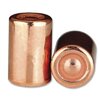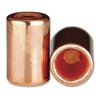Obturation
Member
Hey all,
Looking for some wisdom on projectile design. Of course i'm familiar with wad cutters, my question is - why dont we see many projectiles that are cylindrical ? I've seen the 700 grain 500 magnum cartridges underwood makes, they appear to have a slight shoulder from the pictures but have never seen one in person. My question stems from the fact that i have a quantity of 1/2" copper rod and a friend with a proper lathe. Curious if its tabboo to turn some down for use as revolver projectiles or if thats something that has/can be done. I know copper projectiles are common now but something about this just seems wrong. I suspect theres a reason we dont see such pojectiles offered, just wondering why. I would think with a large meplat and sturdy construction they would be effective. Not that this project would be cost or time efficient, just wondering if i should tinker with it.
Appreciate any input, thanks.
Looking for some wisdom on projectile design. Of course i'm familiar with wad cutters, my question is - why dont we see many projectiles that are cylindrical ? I've seen the 700 grain 500 magnum cartridges underwood makes, they appear to have a slight shoulder from the pictures but have never seen one in person. My question stems from the fact that i have a quantity of 1/2" copper rod and a friend with a proper lathe. Curious if its tabboo to turn some down for use as revolver projectiles or if thats something that has/can be done. I know copper projectiles are common now but something about this just seems wrong. I suspect theres a reason we dont see such pojectiles offered, just wondering why. I would think with a large meplat and sturdy construction they would be effective. Not that this project would be cost or time efficient, just wondering if i should tinker with it.
Appreciate any input, thanks.






